The appeal of blackberry cultivation - high and stable yield. The rich chemical composition of the fruits of shrubs make them particularly important for human diet.It is a worthy alternative to garden raspberries. and the ability to diversify culinary preparations. With proper fit and care, taking into account all the biological features blackberries will bear fruit for at least 10 years.
Table of contents
- When is it better to plant a garden blackberry - in the summer, autumn or spring? Timing choice
- Preparing a place for planting seedlings: where is it better to plant, in the sun or in the shade?
- How to plant in open ground
- How you can and should care for a bush in the garden - tips agrotechnologists
- The golden rule of care - pruning
- Garter of a prickly bush
- Fertilizer and feeding - the key to a good harvest
- When to water, is it necessary to loosen?
- Winter Shelter
When is it better to plant a garden blackberry - in the summer, autumn or spring? Timing choice
The yield potential and benefits of blackberry fruit are much wider than those of its closest relative raspberry. However, gardeners do not seek to plant and grow this magnificent shrub in their plot.
This is due to the fact that plant varieties cultivated from the southern forms have been cultivated for a long time. They are difficult to take root in the planting region and led to a massive disappointment gardeners.
The situation changed after new relatively winter-hardy varieties have appearedthat can withstand temperatures as low as -30 C.
Therefore, for growing in the middle lane or more northern regions (in Siberia and the Urals), it is important to acquire varieties of modern breeding.

In spite of this, Blackberry cultivation is somewhat limited in the northern regions.. This is due to uneven fruiting, the final period of which often coincides with the first frost and some of the fruits do not have time to ripen.
In addition, insufficient lighting leads to a loss of quality in ripe fruit.
Autumn planting blackberry has more benefits and most optimal in the middle and southern regions. After planting shrubs followed by a period with a stable and cool temperature, high humidity will contribute to the development of the roots, while the temperature of the soil does not fall to -4 ° C.
The blackberry leaves the state of relative dormancy very early, and the bushes that have taken root in the fall will immediately begin to develop a vegetative mass.
In the fall, the choice of varieties and seedlings with a fresh root system is much more, and they cost less than the planting material sold in the spring.
Articles that may interest you:
When spring planting plant does not have time to take root due to too rapid warming and the beginning of sap flow, after which the active growth of shoots begins.
Weak root system is not able to provide the necessary nutrition, increasing vegetative mass. This greatly weakens the shrub and affects the overall development.
Spring planting preferred in the northern regions and if the blackberry variety is characterized by poor winter hardiness.
In autumn, the plant should be planted at least 20-30 days before the first frost, in the spring before bud breaks, when the air temperature rises to + 15 ° С.
For cultivation in the garden planting material must be purchased in reputable nurseries. The best survival rate differ annual plants with two stems, the thickness of which is not less than 0.5 cm in diameter.
An important criterion is a formed kidney on the roots.. The optimal length of core roots is at least 10 cm.
Preparing a place for planting seedlings: where is it better to plant, in the sun or in the shade?
For growing blackberries you need to choose a place well lit by the sun and protected from the north winds. In the shade, young shoots of plants will grow poorly, stretch out, the fruits become shallow and lose their taste.
A good option - landing along the fence, where the bush will be protected from the winds, and the stems from damage.In this case, you need to retreat from the fence at 1 m, so that the plant is not much shaded. Shrub is better located on the south or southwest side of the site.
To spread blackberries, breathable and well-drained soil is needed. Ideal loam with a humus layer of at least 25 cm.
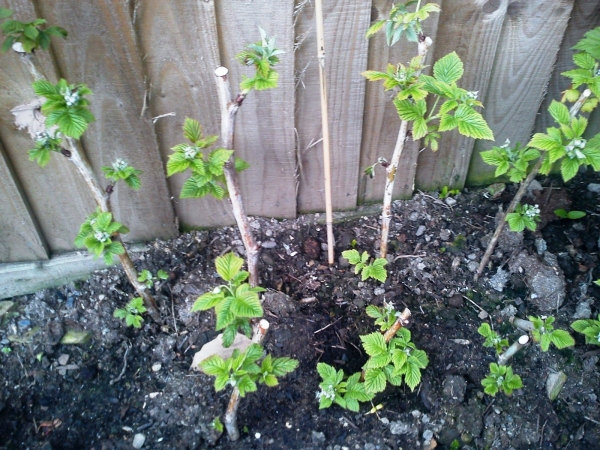
Groundwater deposition at the site should be no higher than 1.5 meters. If these indicators are violated, the roots of the plant will be damp and cold, which significantly affects the winter hardiness and yield indicators.
To plant a prickly bush, you need to prepare a landing area in advance. All weeds are removed, plant waste is destroyed, preventive spraying from pathogens and pests is carried out.
For growing blackberries saline, stony, sandy and marshy areas are not suitable.
Heavily depleted soils need to be fed with the necessary macroelements. For this, the plot is dug up to a depth of 30-35 cm, organic and mineral fertilizers are applied.
How to plant in open ground
Landing pits and substrate are prepared in 15-20 days before planting seedlings in open ground.
Blackberry root system is more powerful and penetrates deeper than other berry crops. Therefore, the pits need to do more voluminous. The best way - stick to the parameters 40x40x40 cm.
Organic matter and minerals should be added to each hole:
- compost or humus 5 kg;
- superphosphate 120 g;
- potassium sulphate 40 g
Nutrient components are mixed with fertile soil and the resulting substrate is poured into a pit by 2/3 volume.
Shrub planted vertically with root penetration 1.5-2 cm. In light sandy soils are buried up to 3 cm.
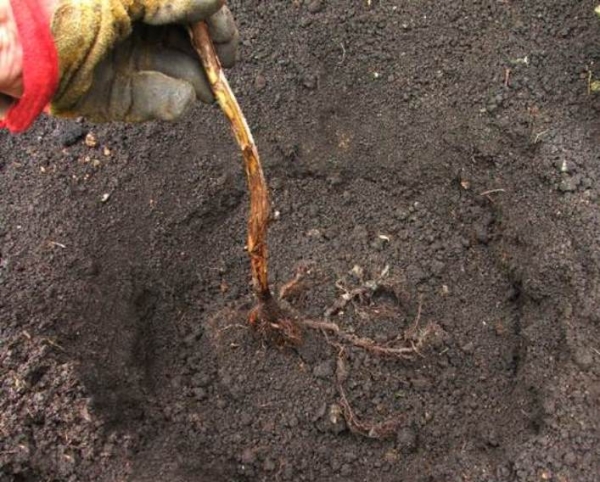
Blackberry roots are placed in the fossa, straightened and covered with substrate. In this case, the pit is not completely filled, leaving a distance of 1-2 cm to the level of the soil.
In this way, under each bush there will be a notch, which will contribute to the rational wetting of the blackberry.
Then the surface of the substrate must be compacted and pour a seedling 5-6 liters of water. After the spring planting of the blackberry plant for 40-50 days you need to ensure regular watering. After soil compaction, the trunk circle is mulch with sawdust, peat or straw.
Planting BlackBerry:
How you can and should care for a bush in the garden - tips agrotechnologists
Blackberries are more drought resistant and unpretentious to care than raspberries. The only lack of culture - relatively low winter hardiness and cold resistance. Therefore, you need to care for the plant with regard to its biological features.
With proper care and preparation for winter, blackberries will grow and delight in high yieldsin terms of which among the berry crops, it is second only to grapes.
The golden rule of care - pruning
A lifelong blackberry you need to control the density of the bush and make forming trimming.
These activities include:
- Removal of inflorescences in the first year of growth. This is done to stimulate the development of the root system.
- In the second year after planting, you need to shorten the stems, leaving a height of 1.5-1.8 m. The procedure is carried out in the spring before bud break. Sections should be made above the kidney.
- After each winter, you need to cut the frozen areas stalks up to live buds.
- In summer, in early June, the shrub is thinned. At the same time young shoots are removed, leaving an average of 6-8 strong stems for creeping varieties and 4-5 for erect. Tops of young shoots are cut by 5-8 cm.
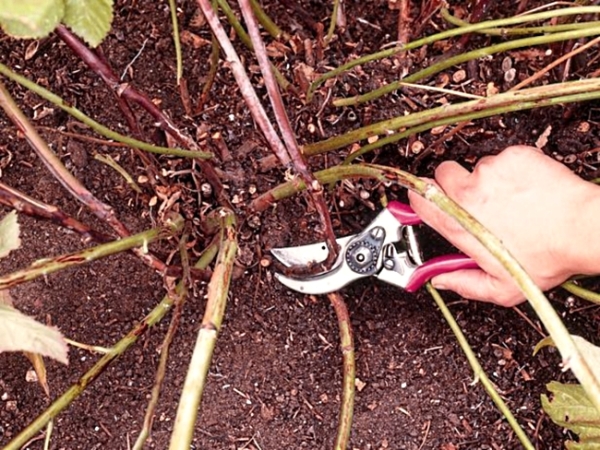
Blackberry Bush - shrub with a two-year fruiting cycle. The first year the stalks of the plant develop, grow wood and form fruit buds. The next year they bear fruit and only in rare cases can they form new fruit buds.
Agrotechnics advise to remove the outgrown biennial shoots, thereby stimulating the development of new growth and thinning the bramble's crown, it will only look better from this.
Garter of a prickly bush
For creeping species of shrub need a trellis with 3-4 rows of wire with a distance of 50 cm between them.
In the first year of development, 2-3 shoots are fan-tied to the bottom wires. Annual shoots are directed to the center of the shrub, tying to the topmost wire.
Before the onset of cold weather, young shoots are removed from the support and make shelter for the winter.
Stalks of upright blackberry varieties tied to a trellis with a slight bias to one side. When new shoots grow during the growing season, they also need to be tied up. This time the slope is made in the opposite direction from the fruit-bearing branches.
Fertilizer and feeding - the key to a good harvest
Every spring blackberry need additional feeding nitrogen fertilizers that will stimulate the growth of annual shoots - this is another golden rule. To do this, under each bush make 50 g of ammonium nitrate, sealing it to a depth of 10-15 cm.
Every 3-4 years the shrub in the garden needs to be fed and other macro elements. This procedure is carried out after harvest.Based on 1 m2 in the soil under the plant contribute:
- compost or humus 10 kg;
- superphosphate 100 g;
- potassium sulphate 30 g
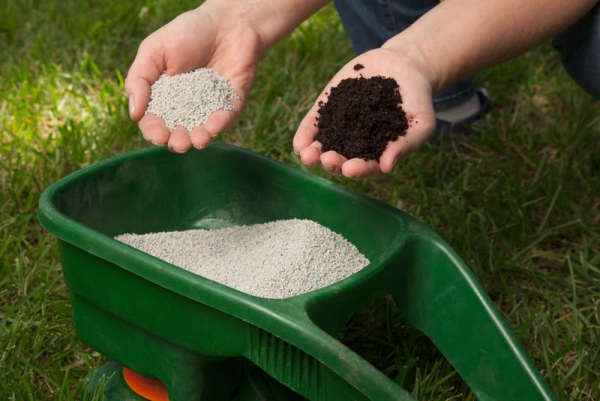
Should remember that nitrogen fertilizers are applied only in spring. Also, this mineral is found in large quantities in pig manure and chicken manure.
Blackberry Fertilizer Events can be combined by spraying 1% Bordeaux liquidwhich will inhibit the development of microorganisms. For additional prevention of diseases, the area under the bushes should be cleaned of fallen leaves.
When to water, is it necessary to loosen?
Deep lying, compared to other berry bushes, blackberry root system makes the plant drought-resistant. But this does not mean that the plant should be left without irrigation and not watered.
Especially needed watering during the filling of the fruit and when setting hot weather. At this time, the wide leafy plates of the plant evaporate a large amount of moisture.
Several times during the growing season need to loosen the soil under the bushes to a depth of 10 cm, simultaneously removing weeds.
It is especially important to carry out the procedure in the fall, at the end of August, in September. The looser the soil is, the less it will freeze through the soil in the root layers.
Winter Shelter
Before the winter season bushes need shelter. For this plant stems bend down to the ground. This is important to do until the air temperature drops to -1 ° C. Otherwise they will lose elasticity and will break.
To do this, the branches are tied in bunches, bending down to the ground and fastening with hooks. Erect blackberry varieties are quite difficult to bend down without breaking the stems.
Many gardeners have found a way out at the end of the growing season, weights are tied to the tops of the stemsunder the weight of which they gradually bend down to the ground.
Regardless of the frost resistance characteristics, all blackberry varieties need shelter for the winter. For this you can apply:
- hay or vegetable tops;
- ruberoid;
- sawdust;
- peat or humus.
Blackberry shelter for the winter:
The most dangerous time for a blackberry is a snowless beginning of winter.. Therefore, it is necessary to cover the plant before the onset of the first cold weather, and in winter to pull snow to it. Blackberry stems are not prone to heating, so the plant can be covered with polyethylene.
Foliage of fruit trees is not suitable as a covering material. It often hides pathogenic microorganisms, which in the spring can begin active development on the shrub.
Blackberry fruiting uneven and may cover a whole month. The fruits of the shrub have good transportability and long shelf life at low temperatures.
Leaves and roots of plants possess bactericidal, sedative properties and will occupy a worthy place in the home collection of herbal remedies.
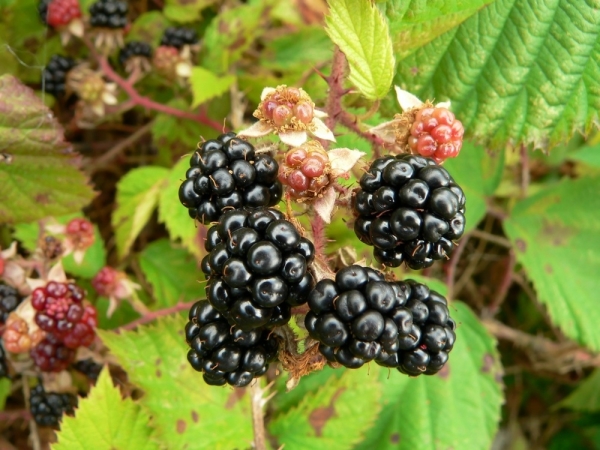
Wonderful video. THANK YOU !!!